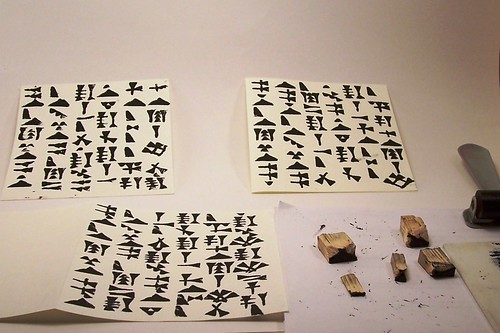The explanations set in courier are part of an explanation sent along with the book, as a small booklet itself.
The Nag Hammadi Codices

The materials used in early single-quire Coptic codices found 1945 near the Egyptian
The books are closed with 5 long leather strips, one at a closure flap that is attached to the front cover, and 2 on each cover at the head and tail. In the centerfold of the signature a so called ‘stay’ is placed which protects the sewing thread from pulling through the papyrus. The pages are bound with two tackets to a spine strip. In some of the books the tackets reaches through the spine of the covers, in others they are is hidden.
The codices found at Nag Hammadi contain Gnostic texts, among them a Coptic translation of the gospel of Thomas, which had been considered lost for centuries. The existence of a gospel of Thomas was known though notes of the Fathers of the Christian Church, who condemned them as heresy. The discovery of the complete gospel (fragments were known since the 19th century) was very important for Christian theology and for our understanding of early Christianity.
My interpretation
For the making of any book one has to decide on the details of the binding technique, what materials to use for the cover and the pages inside, and whether and with what content these are to be filled. Caption: This is the lino block from which I printed the pattern on the Lokta paper.
Caption: This is the lino block from which I printed the pattern on the Lokta paper.Bildunterschrift: Das oben ist der Linoleum Druckstock von dem ich das Muster auf das farbige Papier gedruckt habe.
 Caption: This is how the boards looked like before they became book covers.
Caption: This is how the boards looked like before they became book covers.Bildunterschrift: So sahen die Platinen aus, bevor ich sie bearbeitet habe.
 Caption: Here you can see that I broke off the RAM slots. I also sanded (can you say that, when working with a metal rasp?) the backside, so that it won't hurt the paper.
Caption: Here you can see that I broke off the RAM slots. I also sanded (can you say that, when working with a metal rasp?) the backside, so that it won't hurt the paper.Bildunterschrift: Die Platine während der Arbeit.
After all pieces were ready I scanned the prints, laser-printed them so that they fit into a signature (the original prints form two signatures), and assembled all the pieces. After I finished the piece for Rhonda I bound the original prints into the following book. I will try to sell it together in a box with the wooden wedges and a small booklet that explains my intentions and the materials. The box still needs to be made. I want to place them into an old Laptop, but I am still struggling with preparing it for that task. Enjoy the pictures. (Can you spot the differences to Rhondas book?)
Nachdem alle Teile fertig waren, habe ich die Originaldrucke eingescannt, als eine Lage ausgedruckt (im Original sind das zwei Lagen) und habe alles zusammengesetzt. Als ich das Buch für Rhonda fertig hatte, habe ich die Originalseiten nochmal auf ähnliche Weise gebunden. Also nochmal Boards vorbereiten, - aber diesmal wusste ich wie's geht und habe keine neuen Blasen bekommen. Na, könnt ihr die Unterschiede zu Rhondas Buch sehen? Den größten Unterschied kann man nicht sehen, sondern nur riechen - es riecht nach Druckfarbe, und zwar ziemlich stark! Viel Spaß mit den Bildern:




Now I am waiting for the book I will get - as far as I know it is already on its way. It will be the first book I ever received in a swap, actually, the first handbound book I own that was not done by me, and one of the first that I will hold in my hands. Do I have to say more to convince you that I am waiting impatiently?




1 comment:
Your work just blows me away..I feel privileged to be able to view it online...and the way that you've explained the process here is so insightful...thank you...
Post a Comment